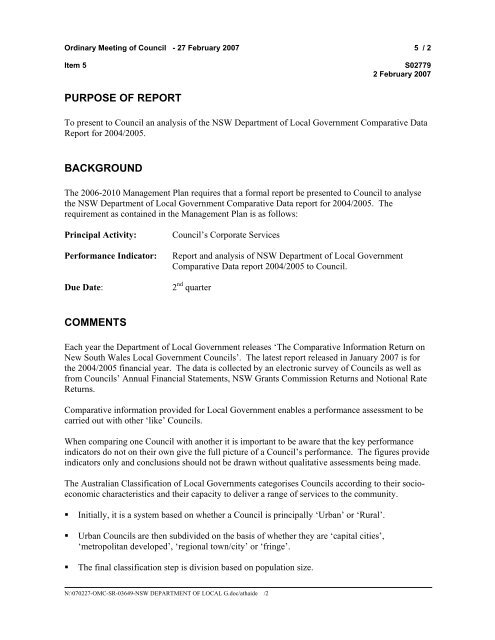27 February 2007 - Ordinary Meeting of Council (pdf. 14MB)
27 February 2007 - Ordinary Meeting of Council (pdf. 14MB)
27 February 2007 - Ordinary Meeting of Council (pdf. 14MB)
Create successful ePaper yourself
Turn your PDF publications into a flip-book with our unique Google optimized e-Paper software.
<strong>Ordinary</strong> <strong>Meeting</strong> <strong>of</strong> <strong>Council</strong> - <strong>27</strong> <strong>February</strong> <strong>2007</strong> 5 / 2<br />
Item 5<br />
S0<strong>27</strong>79<br />
2 <strong>February</strong> <strong>2007</strong><br />
PURPOSE OF REPORT<br />
To present to <strong>Council</strong> an analysis <strong>of</strong> the NSW Department <strong>of</strong> Local Government Comparative Data<br />
Report for 2004/2005.<br />
BACKGROUND<br />
The 2006-2010 Management Plan requires that a formal report be presented to <strong>Council</strong> to analyse<br />
the NSW Department <strong>of</strong> Local Government Comparative Data report for 2004/2005. The<br />
requirement as contained in the Management Plan is as follows:<br />
Principal Activity:<br />
Performance Indicator:<br />
Due Date:<br />
<strong>Council</strong>’s Corporate Services<br />
Report and analysis <strong>of</strong> NSW Department <strong>of</strong> Local Government<br />
Comparative Data report 2004/2005 to <strong>Council</strong>.<br />
2 nd quarter<br />
COMMENTS<br />
Each year the Department <strong>of</strong> Local Government releases ‘The Comparative Information Return on<br />
New South Wales Local Government <strong>Council</strong>s’. The latest report released in January <strong>2007</strong> is for<br />
the 2004/2005 financial year. The data is collected by an electronic survey <strong>of</strong> <strong>Council</strong>s as well as<br />
from <strong>Council</strong>s’ Annual Financial Statements, NSW Grants Commission Returns and Notional Rate<br />
Returns.<br />
Comparative information provided for Local Government enables a performance assessment to be<br />
carried out with other ‘like’ <strong>Council</strong>s.<br />
When comparing one <strong>Council</strong> with another it is important to be aware that the key performance<br />
indicators do not on their own give the full picture <strong>of</strong> a <strong>Council</strong>’s performance. The figures provide<br />
indicators only and conclusions should not be drawn without qualitative assessments being made.<br />
The Australian Classification <strong>of</strong> Local Governments categorises <strong>Council</strong>s according to their socioeconomic<br />
characteristics and their capacity to deliver a range <strong>of</strong> services to the community.<br />
• Initially, it is a system based on whether a <strong>Council</strong> is principally ‘Urban’ or ‘Rural’.<br />
• Urban <strong>Council</strong>s are then subdivided on the basis <strong>of</strong> whether they are ‘capital cities’,<br />
‘metropolitan developed’, ‘regional town/city’ or ‘fringe’.<br />
• The final classification step is division based on population size.<br />
N:\0702<strong>27</strong>-OMC-SR-03649-NSW DEPARTMENT OF LOCAL G.doc/athaide /2
















